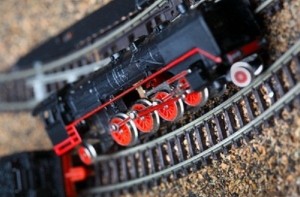Everything on model trains, model railroads, model railways, locomotives, model train layouts, scenery, wiring, DCC and more. Enjoy the world's best hobby... model railroading!
Reducing the Number of Model Train Derailments
It doesn’t matter how carefully you’ve constructed your model railroad, there will be limits to what your model trains can realistically do. One of the most common ways beginners learn this is through experiencing derailments.
 It takes a while to appreciate that most track curve sections on a model layout are typically more exaggerated than the curves that actual real-size trains run on. The basic laws of physics take over when long trains, or high speeds are combined with tight track curves. Something has to give, and more often than not, the train derails. It happens to all of us at times, even those who have been in the hobby for years.
It takes a while to appreciate that most track curve sections on a model layout are typically more exaggerated than the curves that actual real-size trains run on. The basic laws of physics take over when long trains, or high speeds are combined with tight track curves. Something has to give, and more often than not, the train derails. It happens to all of us at times, even those who have been in the hobby for years.
Whilst it may not be possible to completely eliminate derailments, there are preventative measures that can keep derailments to a minimum.
Driver Error
Most road accidents are caused by driver error and sometimes vehicle defects. The same applies to operating a model railroad. To prevent derailments the operator needs to operate the trains with care and attention. The track needs to be in good order as do the trains.
Model trains need to operate at realistic speeds especially around curves or S bends. Operating a train at full speed can be risky, and speed changes need to be gradual. Model trains need to completely stop before they change direction. The operator will need to examine the routing of switches before the train crosses them. This is a sure-fire way of reducing derailments and saving the trains from expensive damage.
Before operating a layout it is well worthwhile watching real trains in action, and try to replicate the scale speeds. A real-size train will typically take a mile or more to come to a complete stop. In a rail yard the train will generally move at under 4mph when coupling cars together. So those kinds of observations should be taken into consideration when operating a model railroad.
Even though it can be somewhat entertaining to watch a model train derail, especially when it is not your own prized possession, it can cause considerable damage. Kids especially like watching train crashes, so staging a train crash can be a way of involving and educating children with the hobby. Derailments can be a way of explaining the physics of train operation and the need for safety. You might be surprised with how the message sinks in when an actual derailment happens.
Mechanical Faults
Even with the best of care derailments can still occasionally happen. Often the cause of the derailment can be difficult to locate. That’s why it is better to avoid derailments in the first place. Correct and careful laying of track can prevent future problems. The clearances and curves need to be accurate. If multiple cars derail at the same spot, then it is probably due to a track problem. If the same car derails in more than just one spot, then it’s likely the car has a fault. There may be exceptions, but that’s generally a good guide. If just one car is derailing in the same place, then a check of both the track and car would be warranted.
So to summarize:
 If the problem occurs at a particular spot, then in all likelihood the track will need a closer inspection. It may take just a small tweaking to remedy the problem.
If the problem occurs at a particular spot, then in all likelihood the track will need a closer inspection. It may take just a small tweaking to remedy the problem.
If the same loco or car derails regularly, then some adjustments may be required to the car or loco. A simple wheel adjustment might fix the problem. Otherwise it could be a coupler problem, or the weight of the car causing the derailment.
Other factors to consider are everyday wear-and-tear on the trains and track. That’s where regular maintenance comes into play as a preventative measure. Tracks and wheels get dirty, so regular inspections of trains and track is generally well worthwhile. Also, be aware of changes in humidity and temperature as these can affect smooth running.
More help with track work and fixing problems.
Locating Problems
Often the best way to locate a problem is to backtrack what happened by repeating the process. Run the train over the same section of track at about the same speed. Get down close to the track so you can spot any problems. You might need to do this several times until you locate the cause. You might need to slow the loco or car down to spot the problem.
The problems that are most difficult to locate and fix are often those that can’t be repeated. Obviously everything needs to be in gauge as you keep a close watch as the train passes the spot.
Although you might be somewhat of a perfectionist, no matter how careful you are, derailments can still happen. That’s why you shouldn’t get too stressed with derailments, but instead, aim to reduce the likelihood of similar problems occurring in the future.




















Leave a Reply